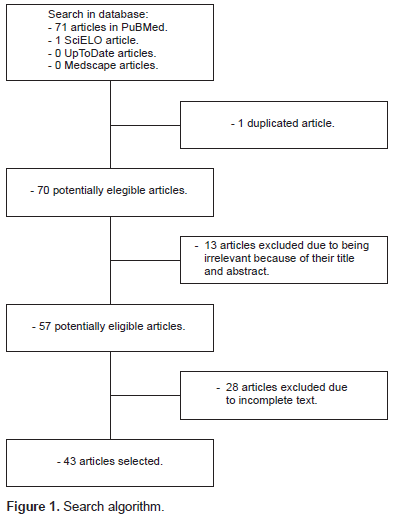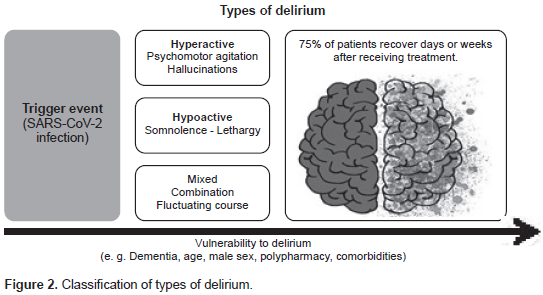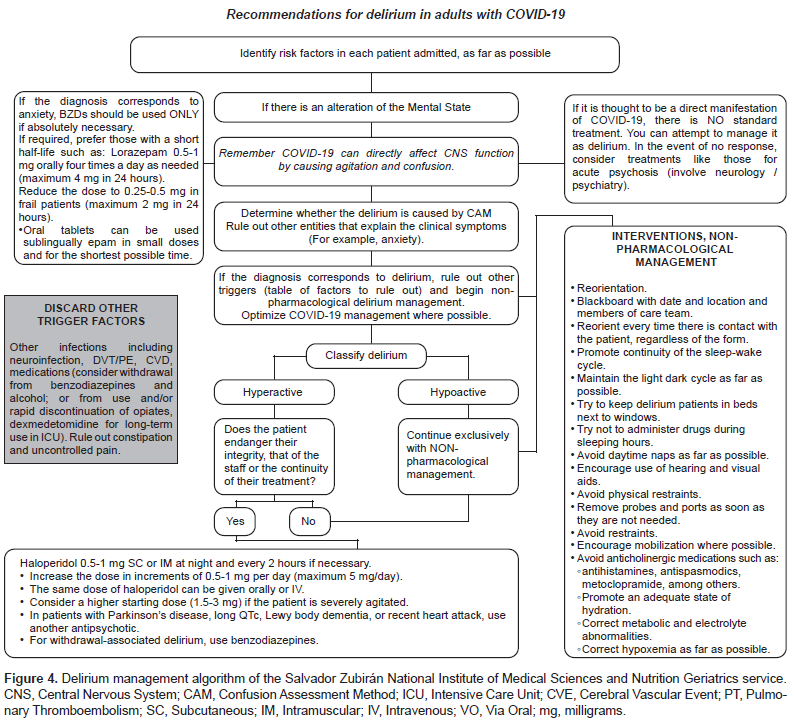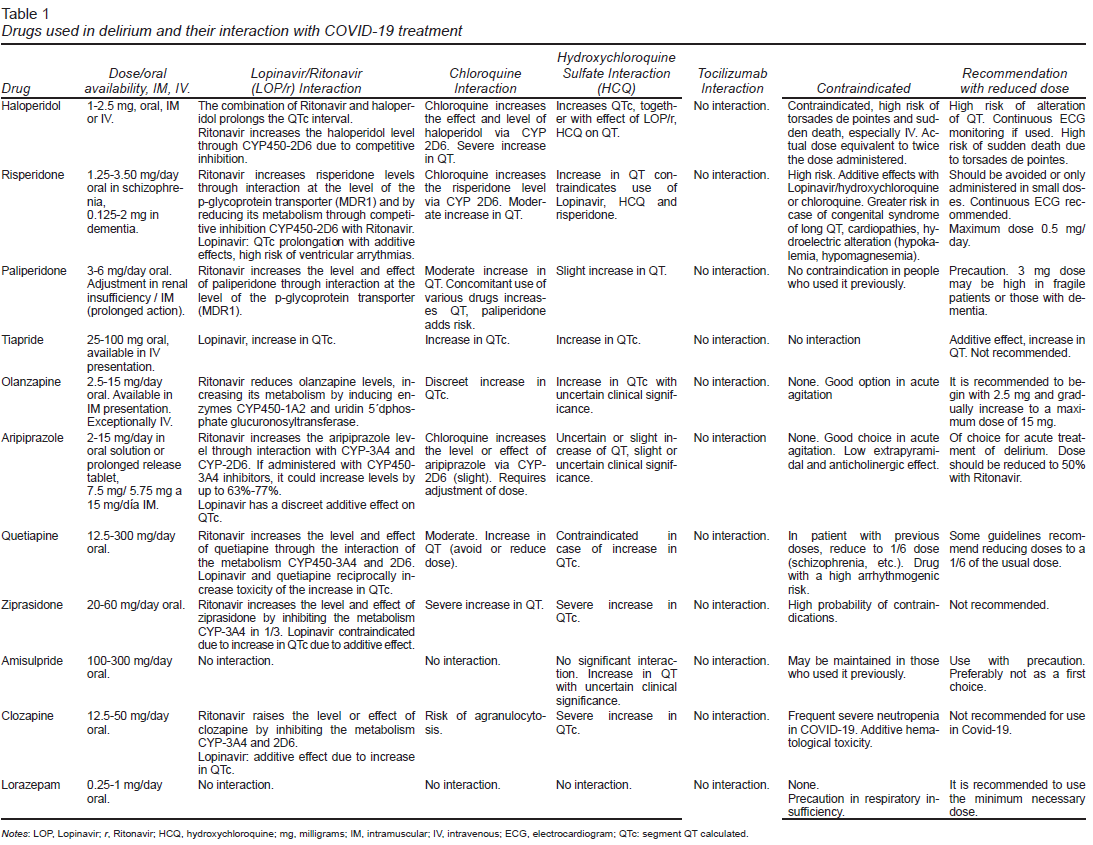Background
The 2019 novel Coronavirus (COVID-19) pandemic began in Wuhan, China in December 2019 (World Health Organization, 2020). This disease is characterized by producing a severe acute respiratory syndrome, caused by the SARS-CoV-2 virus (RNA virus) (Mao et al., 2020). It has severely affected Europe, the United States and the Americas with Mexico being one of the countries in the continente with the highest number of reported cases, after the US and Brazil. By June 21, 2020, Mexico had reported 5,343 new cases, 180,545 accumulated cases, and 21,825 deaths, 31.2% of which correspond to people over 60 (Gobierno de México, 2020; MMS Consulting, 2020). Although COVID-19 typically affects the respiratory system with varying degrees of severity, some patients may experience damage to other organs and systems (renal, cardiac, or hematological), in addition to the central and peripheral nervous system.
One form of presentation of COVID-19 is delirium, defined as a neuropsychiatric manifestation, characterized by an acute change in attention and cognition, with a fluctuating course. It is a common condition in older adults (OA) with physical or mental illness, which increases morbimortality in addition to being considered a geriatric emergency (Kennedy, Hwang, & Han, 2020). The prevalence of delirium associated with COVID-19 in hospitalized patients is 10% to 15% (LaHue et al., 2020; Rogers et al., 2020), although it can increase to 50% to 70% in Intensive Care Units.
Delirium is a well-known complication of respiratory diseases such as pneumonia in older adults. Early studies indicate that 20% to 30% of patients with COVID-19 will present or develop delirium or changes in mental status during the course of their hospitalization, with rates of 60% to 70% in cases of serious illness at all ages (Helms et al., 2020; Mao et al., 2020). The exact mechanisms of this association are probably multifactorial, including direct neurological invasion, cerebrovascular involvement, and more indirectly, through hypoxia, fever, dehydration, inflammation (pro-inflammatory cytokine storm), medications, and metabolic disturbances. Despite this, there has been a worrying lack of attention to the implications of identifying and managing delirium in the response to this pandemic.
Moreover, the presence of delirium in OA increases healthcare resource use and complication rates associated with hospitalization. The presence of a greater number of risk factors and the modification of services during the pandemic (such as the need for isolation in hospitals) due to COVID-19 probably contributes to increasing the presence of delirium in OA (Helms et al., 2020; LaHue et al., 2020; Lovell et al., 2020). Accordingly, the objective of this review is to determine the clinical characteristics, risk factors, pathophysiology, and treatment and prevention measures for delirium associated with COVID-19.
Method
A review of the literature on delirium and COVID-19 was conducted using the following search engines: PubMed, SciELO, UpToDate, and Medscape. The search was limited to human studies and included documents published during the period from December 2019 to June 2020, and publications that included countries affected by COVID-19. The following keywords were used in English and Spanish, with MeSH terms: “COVID-19,” “Delirium,” “Elderly,” “Pandemic,” “SARS-CoV-2,” “Pathophysiology,” “Treatment,” “Complications,” “Prevention,” “Clinical Guidelines,” and “Clinical Trials” to answer the following research question: What are the clinical characteristics, risk factors, pathophysiology, and delirium treatment and prevention measures associated with COVID-19 in Older Adults?
For the inclusion criteria, articles related to delirium and COVID-19, descriptive, prospective, or retrospective studies, reviews, letters to the editor, as well as related clinical practice guidelines were considered. Only articles in which it was not possible to have full access to the contents, as well as those in a language other than Spanish or English or which did not provide full access to the text, were excluded.
An initial search was conducted, yielding 72 results. Articles were organized according to the inclusion and exclusion criteria, the main ones being review articles in English, clinical practice guidelines, and letters to the editor. Once all the sources had been included, they were organized by topic and lastly 43 articles with relevant information were selected for the narrative description of the review (Figure 1).
Risk factors for COVID-19 disease and aging
The risk in OA of developing delirium is due to the changes inherent in aging, and possibly the greater number of risk factors previously described for delirium (Marcantonio, 2017), although not all OA will necessarily suffer from delirium. One predisposing factor is immunesenescence, characterized by a decrease in the function of the innate, adaptive immune system, which affects the body’s ability to respond to pathogens (Tay, Poh, Rénia, MacAry, & Ng, 2020). Immunosenescence triggers a phenomenon called inflammation due to advanced age (inflammaging), which maintains a chronic, low-grade, subclinical inflammatory state, which in turn continuously produces pro-inflammatory cytokines (IL-1) and Tumor Necrosis Factor alpha (TNF alpha), as well as a decrease in immunomodulatory cytokines (IL-2). This low-grade inflammation is called the senescence-associated secretory phenotype (SASP). These physiological changes could explain the greater severity of COVID-19 in OA. At the same time, there are also molecular changes in the Central Nervous System (CNS), such as, for example, the deterioration of mitochondrial function, oxidative stress, changes in energy metabolism, and alteration in the synthesis of neurotransmitters, which make OA more vulnerable to presenting delirium (Di Benedetto, Müller, Wenger, Düzel, & Pawelec, 2017).
Physiopathological mechanisms of COVID-19
on the Central Nervous System
Neurological symptoms have been described in severe forms of COVID-19 or severe COVID-19 more often than in those with mild symptoms (Kotfis et al., 2020). In a series of 214 patients with COVID-19, Mao et al. (2020) demonstrated that 36.4% developed neurological symptoms (such as headaches, impaired consciousness, or paresthesias). In turn, Xiang et al. (2020) reported the first case of SARS-CoV-2 viral encephalitis in China, showing, through the analysis of cerebrospinal fluid and genome sequencing, the ability of this virus to damage the nervous system. Initially, knowledge of the neurotropism of SARS-CoV-2 could be explained by the genetic similarity (79.5%) with SARS-CoV (Wu et al., 2020a). Current evidence shows that some COVID-19 patients have symptoms like those of an intracranial infection (headaches, epilepsy, and disturbances of consciousness) (Wu et al., 2020b). At the same time, there is evidence that some patients have symptoms related to COVID-19 after neurological manifestations such as hypogeusia or hyposmia, (Mao et al., 2020; Mimenza-Alvarado, Avila-Funes, & Aguilar-Navarro, 2020).
Toxic infectious encephalopathy (TIE), also known as acute toxic encephalitis, is a syndrome of reversible brain dysfunction caused by the presence of systemic toxemia, metabolic disorders, and hypoxia during the acute infection process. It is important to mention that this encephalopathy was initially described in patients with influenza or severe sepsis (Mizuguchi, Yamanouchi, Ichiyama, & Shiomi, 2007; Tauber, Eiffert, Brück, & Nau, 2017). From a pathophysiological point of view, it is related to the presence of cerebral edema without evidence of inflammation in the cerebrospinal fluid (CSF). Clinically, patients may present headaches, dysphoria, and delirium, although in some cases there may be loss of consciousness and coma. As mentioned earlier, patients with COVID-19 can present neurological symptoms in up to 50% of cases. Autopsy studies of patients who suffered from this disease have confirmed the presence of cerebral edema. Accordingly, COVID-19 is likely to produce a TIE, although more studies are required to confirm this theory (Xu et al., 2020).
Coronaviruses (CoVs) can directly affect the nervous system since the presence of genetic material and certain proteins in the nervous system has been demonstrated. Other pathways related to the involvement of the nervous system are through blood circulation (little evidence for SARS-CoV-2), neuronal, hypoxia (associated with cerebral edema, intracranial hypertension, among others) (Abdennour, Zeghal, Dème, & Puybasset, 2012; Mao et al., 2020). As mentioned earlier, alterations in the cellular immune system may also explain the damage to the nervous system, since neurotropic viruses activate glial cells to induce a pro-inflammatory state through the release of interleukins (IL), mainly IL-6 (related to the pro-inflammatory cytosine storm) that occurs in severe COVID-19 (Wan et al., 2020). The relationship between the changes described and inflammation due to advanced age (inflammaging) (also associated with the release of IL-6) probably explains the presence of delirium in this age group. In addition, plasma levels of other pro-inflammatory cytokines (IL-8, IL-10, IL-2) are higher in patients with severe COVID-19 (Troyer, Kohn, & Hong, 2020).
Finally, the presence of angiotensin-converting enzyme 2 (ACE2) in the CNS is related to damage to the blood-brain barrier (BBB), which could facilitate the penetration of the virus into the CNS through the vascular system (Baig, Khaleeq, Ali, & Syeda, 2020).
Clinical characteristics and diagnosis
of delirium in COVID-19
The presence of delirium could also be an early symptom of COVID-19, which is why, in all OA patients, any respiratory or gastrointestinal symptoms that suggest this disease should be investigated (Alkeridy et al., 2020). The current recommendation in OA care in times of the SARS-Cov-2 virus pandemic is early detection of delirium (Figure 2).
In the absence of a specific scale for the diagnosis of delirium in a patient with COVID-19 it is recommended to use the Confusion Assessment Method (CAM) (figure 3), which is the most widely used tool, it is brief, and does not require prior training, in addition to having 46%-94% sensitivity and 63%-100% specificity in the context of delirium due to any cause (British Geriatrics Society, European Delirium Association, & Old Age Psychiatry Faculty, 2020; Davis, Searle, & Tsui, 2019; Herling et al., 2018).
Delirium is characterized by its fluctuating condition, so it is advisable to question the family and/or caregiver regarding the previous mental state, since there could be a history of dementia, vascular lesions, or even a previous history of delirium. It is advisable to consider, once the diagnosis of SARS-CoV-2 infection has been ruled out (or confirmed), complementary studies to rule out or confirm other conditions that could also contribute to delirium and, depending on the clinical context, run further studies that will make it possible to document a direct disorder of the CNS (cerebral vascular event, encephalitis, thrombosis, among other causes) with neuroimaging studies or the analysis of the CSF (Marcantonio, 2017). Once SARS-CoV-2 infection has been ruled out, any direct CNS disorder (discussed above) or any hydrolectrolytic disorder, infection of another system or organ, recent use or adjustment of drugs, metabolic decontrol, presence of pain, or any other pathology that could explain delirium should also be discounted (Ford, 2016).
Interventions in delirium and COVID-19
Non-pharmacological interventions
Although delirium associated with COVID-19 in OA might appear to be an unavoidable condition, by using preventive measures it is possible to reduce its emergence in 30% to 40% of cases. Standardized protocols have been shown to improve the quality of care in hospitalized patients (by preventing functional and cognitive deterioration), such as the Hospital Elder Life Program (HELP), which includes an intervention program in the areas of mobility, sensory and auditory alterations, orientation, nutrition, hydration, and the sleep-wake cycle. This program has been successfully implemented in over 30 hospitals worldwide (Ferrarese et al., 2020). At the same time, OA who are being treated at ICUs (Intensive Care Units), where delirium prevention and care measures have also been shown to have a great impact, should be considered. One of the recommended models is the one proposed by the Society of Critical Care Medicine (SCCM), which includes management of analgesia, sedation, and delirium care (Barr & Pandharipande, 2013). Through the ICU Liberation initiative, Wesley Ely’s group promotes the protocol that includes the following: (Assess): pain prevention and management measures, (Both): evaluation of the state of consciousness, breathing and analgesia-sedation, (Choice): evaluate and prevent Delirium, (Early): mobility and early exercise, (Family): commitment and accompaniment, known as the ABCDEF of delirium (Assess, Both, Choice, Delirium, Early, Family) (Baller et al., 2020; Ely, 2017; LaHue et al., 2020; Pahlevan et al., 2017; Strijbos, Steunenberg, van der Mast, Inouye, & Schuurmans, 2013).
Delirium prevention programs are essential in the era of COVID-19 and should not be omitted, despite the challenges related to the measures established in hospitals, such as, for example, the prohibition of visits to patients, the need to use face masks as well as personal protective equipment (PPE). Since their intervention could reduce isolation, favor daytime stimulation, regulate the sleep-wake cycle, and monitor the individual needs of the patient a key aspect is the role played by health personnel in delirium prevention (Park & Lee, 2019). For this reason, current recommendations consider the support of a caregiver/family member accompanying the OA during COVID-19 care, always using PPE, and attending for short periods (LaHue et al., 2020). Figure 4 shows some strategies adapted to the Mexican environment, with an emphasis on the evaluation and prevention of delirium in patients hospitalized in acute care wards and/or who are discharged from ICU.
Pharmacological treatment
Current recommendations state that drug treatment should only be started in patients with delirium who present agitation, aggression, paranoia, hallucinations, and/or when, in addition, these symptoms pose a risk of imminent harm to the patient or their caregiver (Meagher et al., 2020). For the choice of the antipsychotic agent, the desired clinical effect, pharmacokinetic, and pharmacodynamic profile, as well as its safety (adverse effects), should be considered (Ostuzzi et al., 2020). The characteristics of the antipsychotics used in the treatment of delirium in general, as well as some considerations in the treatment for COVID-19 and their potential risk of interactions with the antipsychotic, are shown in Table 1.
In its clinical practice guide for the treatment of delirium and COVID-19, The British Geriatrics Society (BGS) recommends screening for delirium in risk groups (pre-existing cognitive impairment, depression, men, sensory deprivation) and regular evaluation of their mental state, in addition to ruling out any other possible precipitating factor. For cases in which rapid control of symptoms is required, such as agitation, the first-line recommendation is haloperidol (maximum dose 5 mg in 24 hours) (di Giacomo et al., 2020). However, it should be recalled that in OA with Parkinson’s disease or Lewy body dementia, the use of this drug could exacerbate extrapyramidal symptoms (Ward & Citrome, 2018).
At the same time, patients with perceptual and circadian cycle disorders may benefit from the use of sedative antipsychotics, such as quetiapine (Atkin, Comai, & Gobbi, 2018). Regarding dosage, antipsychotics should be started at low doses on a daytime basis, as needed and according to the severity of the patient’s symptoms. Conversely, if frequent doses are required, they should be gradually increased and modified according to the clinical evolution of the patient, reserving the daytime dose for use as required (Rieck, Pagali, & Miller, 2020). Benzodiazepines are generally considered a poor option for delirium treatment. However, it has been observed that in patients with COVID-19 and severe agitation, the use of lorazepam in combination with antipsychotic agents could allow greater sedation, although patient vigilance should be extreme due to the risk of presenting respiratory depression in patients with pneumonia (Ostuzzi et al., 2020). It is important to note that to date, according to the evidence, prophylactic use of antipsychotics is not recommended in the context of delirium associated with COVID-19 (Finucane et al., 2020).
Since antipsychotics may have interactions related to QTc prolongation with certain drugs commonly used in COVID-19 (azithromycin), with a greater risk with the use of typical antipsychotics, the risk of interaction can be reduced when using atypical antipsychotics such as risperidone or olanzapine (Frontera et al., 2020).
At the same time, special care should be taken with the use of antipsychotics and opiates, since morphine, for example, plus risperidone require monitoring the respiratory rate and blood pressure, so it is recommended to reduce the dose of either of the two and use the minimum effective dose of both and for the shortest possible time, to avoid the risk of respiratory depression and/or arterial hypotension (due to the additive effect). This recommendation also applies to haloperidol. In the case of morphine and quetiapine, the presence of constipation/paralytic ileus or any other anticholinergic effect should be monitored (Ostuzzi et al., 2020).
The combination of morphine and hydroxychloroquine sulfate may increase the risk of seizures (due to the additive effect). There is no known interaction between chloroquine and morphine, or between the latter and tocilizumab (University of Liverpool, 2020).
Discussion and conclusion
The studies included in this review show that patients with COVID-19 presented neurological manifestations that include the central and peripheral nervous system, since it causes hypogeusia, anosmia, cerebrovascular disease, headache, altered state of consciousness, and neuropathy (Mimenza-Alvarado et al., 2020). It is considered that delirium could be an early manifestation in OA with this disease, so it is important to identify it routinely, since inadequate or delayed diagnosis is associated with greater morbidity and mortality (Rieck et al., 2020).
The pathophysiology of delirium in COVID-19 is related to a direct mechanism through the involvement of the virus in the CNS, causing toxic infectious encephalopathy, or caused by hematogenous dissemination, as well as indirect effects (systemic and cerebral hypoxia) and inflammatory alterations, among others. These changes, together with the low-grade inflammation that accompanies aging, could be elements that encourage the presentation of severe forms of COVID-19 in OA, also associated with comorbidity and risk factors (Tay et al., 2020).
Regarding its treatment, recent studies have documented the lack of efficacy and the potential for adverse events related to the use of antipsychotics to treat delirium associated with COVID-19 (Nikooie et al., 2019). While non-pharmacological approaches are effective and the mainstay of delirium treatment, aspects such as reorientation, maintaining communication, early mobilization, relaxation exercises, and maintaining the sleep-wake cycle could be more difficult to implement in times of COVID -19. Nevertheless, these measures should be a priority for its management (Blanco Artola, Gómez Solórzano, & Arce Chaves, 2020).
At the same time, implementation of delirium prevention measures is essential, particularly in patients with hospital management for COVID-19, since isolation, restrictions on family visits, limited physical contact with health personnel, and the use of PPE can depersonalize and impress OA, particularly those with underlying dementia or cognitive impairment (LaHue et al., 2020). The current approach has resulted in intense social isolation, as well as increased use of physical and pharmacological restraints for anxiety and agitation management, which can increase the risk of developing delirium, exacerbate and prolong the duration of the disease, and increase mortality. While there may be a tendency in these difficult times to opt directly for drug treatment for delirium, this approach should only be adopted in the most challenging cases, when there is a threat of extubation or interruption of essential medical therapies (O’Hanlon & Inouye, 2020). Thus, only by knowing the behavior of delirium in these patients will we be able to reduce and treat delirium in OA in a comprehensive, multidisciplinary way.
As a result of the dynamic changes in knowledge related to the COVID-19 pandemic and the constant change in treatment guidelines, the recommendations issued in this review are limited, and most of the studies included were descriptive in nature, with a range of methodological quality. Accordingly, it is not possible to establish an objective comparison among the results. However, the strength of this review is based on the fact that current recommendations for delirium treatment in COVID-19 a like the general recommendations for delirium in OA and have shown an impact on reducing morbidity and mortality.
Since older adults with COVID-19 are vulnerable to presenting delirium as an early, severe manifestation of the disease or as a complication of it, it is necessary to implement prevention measures, as well as non-pharmacological and pharmacological treatment for those suffering from it. Current recommendations in COVID-19 treatment do not routinely include delirium risk assessment, which could lead to under-detection of delirium during the COVID-19 pandemic, particularly in OA.




